9 Common Branding Mistakes That Can Cost You Big
Tropicana redesigned its iconic orange juice packaging in 2009, swapping its familiar logo for an elegant, minimalist look. The result? A $30 million sales drop in just two months, forcing the company to revert to the original design. This is a prime example of how common branding mistakes can cost businesses not just money, but also customer trust and loyalty.
Branding is more than just a logo or a catchy slogan—it’s the emotional connection between a company and its audience. A study by Lucidpress found that consistent branding increases revenue by 33%.
However, many businesses still fall into branding pitfalls that weaken their impact. From inconsistent messaging to ignoring audience insights, these mistakes can damage credibility and growth.
In this blog, we’ll uncover 9 of the most common branding mistakes and how to avoid them. Whether you’re building a brand from scratch or refining an existing one, these insights will help you create a lasting, powerful identity.
Branding Mistakes That Are Killing Your Digital Growth
Check out the below listed common branding mistakes that you as a brand need to avoid to succeed.
1. Not Defining Your Target Audience
One of the most common branding mistakes is trying to appeal to everyone. When you aim too broad, your message loses focus, your engagement weakens, and your brand ends up merging instead of standing out.
Think about it—would a Gen Z college student shopping on a budget connect with a premium luxury skincare brand that speaks in a high-end, clinical tone? Unlikely. That disconnect happens when you don’t clearly define who you’re talking to.
To avoid this, get specific. Ask yourself:
- What are their interests, habits, and challenges?
- Where do they live, and how do they shop?
- What’s their age, lifestyle, and income bracket?
- What kind of messaging or visuals resonate with them?
The clearer your understanding, the stronger your branding. Speaking directly to your ideal customer makes your brand feel relevant, personal, and trustworthy. Skip this step, and you risk becoming just another name in a crowded market.
– Also Read- What is Branding and Why Does It Matter?
2. Ignoring the Importance of Brand Identity
Many still mistake brand identity for just a logo or a color palette. But in truth, your brand identity runs much deeper; it’s the heartbeat of your business. It includes your mission, values, belief system, brand voice, and overall personality. Without clear direction, your brand becomes forgettable, and trust becomes hard to earn.
A well-defined brand identity gives your audience something to connect with. It builds emotional ties, drives recognition, and leads to higher conversions. From your social media presence and marketing campaigns to customer service and packaging, every touchpoint should reflect a unified brand personality. If it doesn’t, your brand can feel scattered and inconsistent.
Take Glossier, for example. This modern beauty eCommerce brand has built a loyal following not just with its minimalist packaging, but through its clear voice—approachable, inclusive, and community-driven. Every detail from their website layout to product copy and social media tone reinforces their brand identity. That consistency has helped turn customers into ambassadors.
The solution? Craft strong brand guidelines centered around your target audience. Define your visuals, tone, and messaging clearly so every interaction feels cohesive and authentic.
– Also Read- Brand Identity vs. Brand Image: Understanding the Difference and Why it Matters
3. Lack of Inconsistency Across All Touchpoints
Consistency isn’t just about using the same logo or brand colors; it’s about delivering a cohesive experience everywhere your audience interacts with you. If your brand looks and sounds different on each platform, you’re sending mixed signals that can confuse and push potential customers away.
This kind of inconsistency shows up in many ways:
- Conflicting visual identity across your website and social media
- Campaign messaging that feels off-brand or opposes past communication
- Irregular posting or sudden “ghosting” on platforms
- The tone shifts between channels; professional on LinkedIn and casual on emails
- Mismatched logos, fonts, or designs that feel disconnected
When your brand voice, visuals, and message align, you build trust and become instantly recognizable. That’s why a clear brand style guide isn’t just nice to have; it’s a must. It ensures that no matter where someone finds you, the experience feels familiar, intentional, and polished.
Inconsistency can make your brand forgettable. Stay consistent, and you’ll stay top of mind.
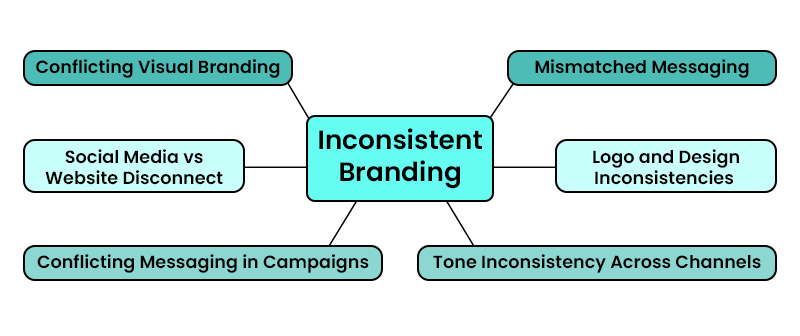
4. Neglecting Storytelling
One of the common branding mistakes is relying only on facts and features. While data matters, it doesn’t create an emotional connection. People don’t just buy products; they buy:
- Stories that inspire
- Experiences that resonate
- Emotions that make them feel connected
Think about brands like Nike, Apple, or Patagonia—they don’t just sell shoes, tech, or outdoor gear. They inspire:
- Nike- A movement of perseverance and excellence
- Apple- Innovation and creativity
- Patagonia- Sustainability and adventure
Your tone and voice play a huge role in this. Whether bold, friendly, or inspiring, it should reflect your brand’s personality and values.
A strong brand presence comes from a compelling, consistent story. Without it, your brand risks blending in. Create a narrative that resonates, builds loyalty, and makes customers feel part of something bigger!
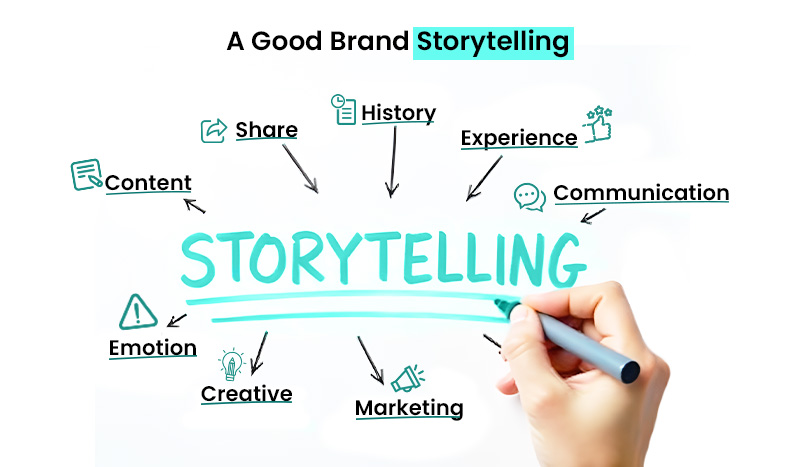
For example, Nike’s storytelling often highlights personal stories of athletes overcoming hardship. This narrative branding strategy not only showcases Nike’s products but also inspires and motivates its audience, supporting Nike’s brand identity, which is centered on determination and excellence.
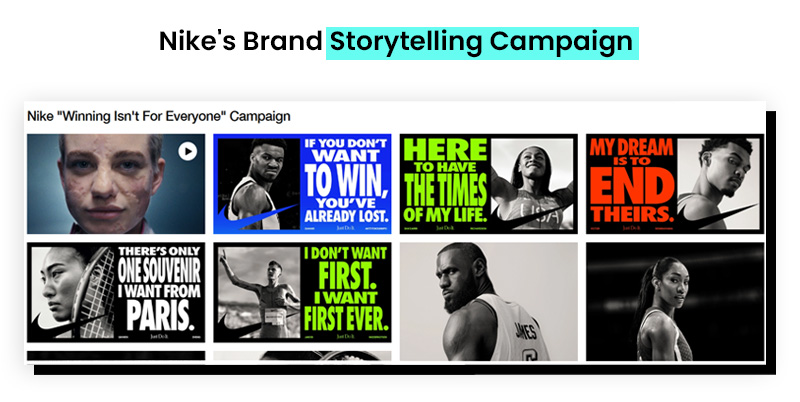
– Also Read- The Power of Narrative: How To Drive Action Through Brand Storytelling
5. Failing to Adapt and Evolve with Market Trends
Attaching too tightly to a fixed brand identity might feel safe, but it’s a risky move in today’s fast-changing landscape. Markets shift, trends evolve, and consumer expectations constantly grow. Brands that fail to adapt often find themselves falling behind, no matter how strong their foundation once was.
Among the common branding mistakes, ignoring the need for evolution is one that can quietly damage your relevance. Whether it’s updating your visual identity, refreshing your messaging, or staying current, show your audience that your brand is aware and ready to meet their needs today—not yesterday.
Take Netflix, for example; it started as a DVD rental service but shifted to streaming and later expanded into original content. That adaptability turned it into a global entertainment powerhouse. On the other hand, brands like Blockbuster failed to recognize the shift in consumer behavior and paid the price.
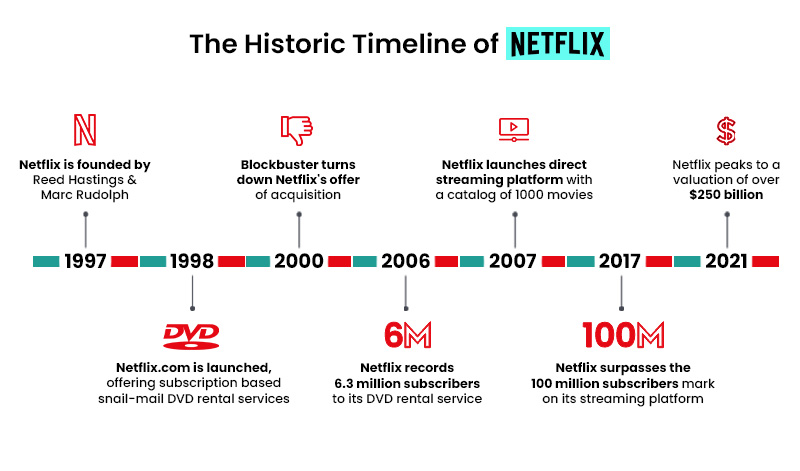
Your brand should reflect your growth, innovation, and what your audience values today; not just what worked years ago. Staying fresh doesn’t mean losing your identity; it means refining it to stay relevant, competitive, and memorable in a fast-changing world. Adapt the market trends or risk being left behind your competitors.
6. Overlooking Customer Feedback
One of the most significant branding mistakes is overlooking what your customers are telling you. Feedback isn’t just criticism; it’s a roadmap to building a stronger brand.
Successful digital branding relies on understanding customer needs, preferences, and pain points. Ignoring feedback can damage your reputation, weaken customer loyalty, and make your brand feel disconnected.
Think of brands that refused to listen, many struggled or faded away. On the other side, companies like Starbucks thrive because they actively adjust based on customer input.
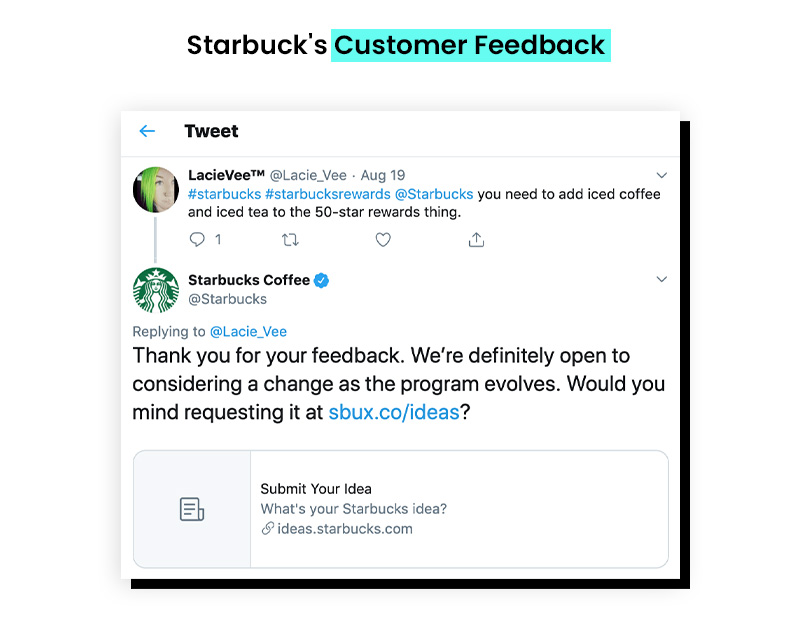
So, how do you gather feedback?
- Use surveys
- Social media polls
- Reviews
- Direct interactions through customer service channels
But collecting data isn’t enough, you have to act on it. Whether it’s improving products, refining messaging, or adjusting your brand’s tone, integrating customer insights ensures your brand stays relevant, trusted, and ahead of the competition.
7. Misunderstanding Branding vs. Marketing
Many businesses confuse branding with marketing, but they’re not the same thing. Let’s understand this:
- Branding is who you are; your values, personality, and the emotional connection you create with your audience.
- Marketing is how you promote that identity through campaigns, ads, and outreach.
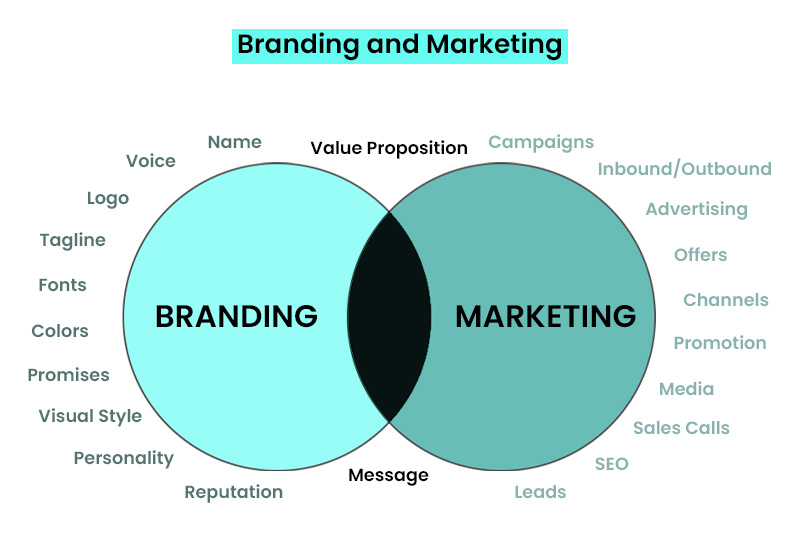
If you focus only on marketing without a strong overall brand, your efforts can feel scattered and ineffective. Imagine spending money on ads but failing to create a brand that people recognize and trust. That’s a wasted opportunity.
Your branding should guide your marketing. Before launching campaigns, define how you want to represent your brand—its voice, mission, and what makes it unique.
When branding and marketing work together, you attract the right audience and build long-term loyalty, rather than just chasing short-term wins.
– Also Read- Brand Voice: 7 Top Things to Consider in Brand Building
8. Mismanaging Social Media
Social media isn’t just a place to post updates; it’s a powerful tool to build a strong brand and connect with your audience. Yet, one of the most common branding mistakes is either ignoring social media or mishandling it.
Brands that actively engage by responding to customers, sharing valuable content, and owning their mistakes; win trust and loyalty. On the other hand, some brands also faced backlash for poorly timed posts.
If your brand isn’t dedicating time to social media, you’re missing out. Customers expect interaction, whether it’s answering questions or addressing concerns about your product or service.
The brands that succeed are the ones that use social media not just to sell, but to create meaningful connections with their audience.
9. Inadequate Visual Identity
Your brand’s visuals aren’t just decoration; they shape how people perceive your business. A weak logo design, conflicting colors, or inconsistent fonts can make your brand look unprofessional and forgettable.
Think about brands like Apple or Nike. Their defined brand identity is instantly recognizable, thanks to clean design and consistent use of colors and typography.
On the other hand, brands that constantly change their look or use inadequate visuals struggle to build trust. To get it right, choose brand assets that reflect your values and audience.
Stick to a cohesive color scheme, legible fonts, and high-quality imagery. A polished, strategic visual identity can make all the difference in how your brand is perceived and remembered.
– Also Read- Power Of Visual Content Marketing: The Visual Revolution
Conclusion
Branding is more than just a logo; it’s the experience, trust, and connection you build with your audience. Knowing how to avoid common brand mistakes can save your business from setbacks and missed opportunities.
Whether it’s staying consistent, listening to customers, or adapting to trends, every choice shapes your brand’s success. The key is to be intentional and strategic.
Keep refining your brand, stay true to your identity, and focus on what relates to your audience. A well-crafted brand isn’t just memorable—it’s unstoppable.
Mastroke provides digital branding strategies that can enhance your branding appeal and grow your business. For a customized branding action plan— reach out to us now!
FAQs
1. What is considered a brand failure?
A brand failure occurs when a product is unable to capture enough market share to maintain its presence. It could also mean the product doesn’t live up to its expected lifecycle or fails to deliver the profitability projected by the company regardless of the reason. In nature, it’s when a brand or product falls short of business goals and consumer acceptance.
2. What are 5 notable digital branding failure stories?
Here are some unforgettable examples where branding missteps led to major fallout:
- Colgate Frozen Dinners (1982)
- McDonald’s Arch Deluxe (1996)
- TiVo (1999)
- Juicero (2017)
- Tropicana Packaging Redesign (2009)
3. What is the 60/40 rule in branding?
According to research by the IPA, successful brands should split their marketing efforts using the 60/40 rule:
- 60% of the budget should be allocated to long-term brand building—focusing on emotional connection, awareness, and consistency.
- 40% should go toward short-term sales activation—campaigns that drive immediate results.
Balancing both helps maintain visibility while also delivering conversions.
4. What are the most common branding mistakes startups make?
Startups often make branding mistakes like inconsistent messaging, neglecting a strong brand identity, targeting the wrong audience, weak logo design, ignoring customer feedback, and copying competitors. Failing to adapt, poor social media strategy and unclear brand values also hinder success.
